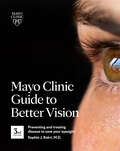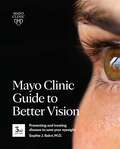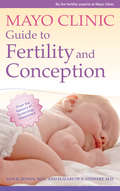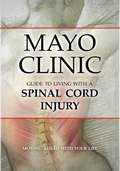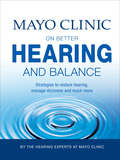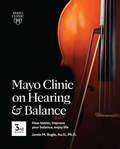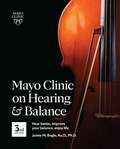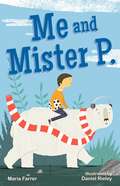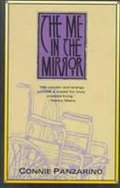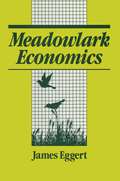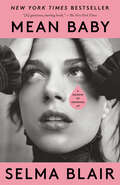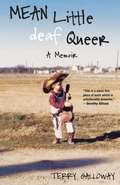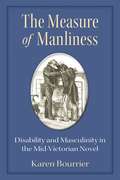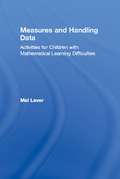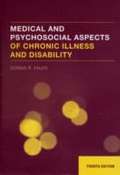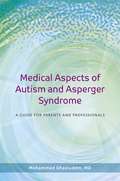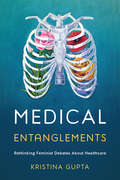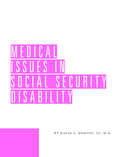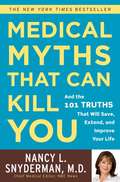- Table View
- List View
Mayo Clinic Guide to Better Vision, 3rd edition: Preventing and Treating Disease to Save Your Eyesight
by Sophie J. BakrMany routine tasks depend on good eyesight, whether it&’s choosing clothes to wear, preparing a meal, driving a car or searching the Internet. These tasks help maintain your well-being and quality of life. So, keeping your eyes healthy and preserving your vision are critical lifetime investments. Dangers to vision include common conditions such as age-related macular degeneration, glaucoma, diabetic retinopathy, and cataracts. Many eye injuries occur each year, some of which cause permanent vision loss. More than 170 million Americans wear eyeglasses or contact lenses to help them see better —and spend billions of dollar annually on eyewear. Despite these measures, more than 12 million people older than age 40 are visually impaired. Mayo Clinic Guide to Better Vision is written in a clear, conversational style, supported by illustrations, photographs, and tables. It is a practical resource for making the most of your vision: keeping your eyes healthy and your eyesight sharp at any age.
Mayo Clinic Guide to Better Vision (3rd Edition): Preventing and treating disease to save your eyesight
by Dr. Sophie J. BakriHaving good eyesight is essential for almost every activity we do, but an estimated 93 million adults in the United States are at high risk for serious vision loss. Mayo Clinic Guide to Better Vision is a comprehensive guide to understanding common vision problems, preventing age-related eye disorders, and keeping your eyes healthy at every stage of life.As we age, our eyes become more susceptible to common conditions like age-related macular degeneration, glaucoma, diabetic retinopathy and cataracts. Even younger adults can suffer from painful eye conditions like dry eyes, infected tear ducts, styes, floaters, pink eye, and eye strain. More than 170 million Americans wear eyeglasses or contact lenses to correct vision problems, and those number is likely to increase. Fortunately, many of these conditions are preventable, treatable, and even reversible. In Mayo Clinic Guide to Better Vision, Dr. Sophie Bakri, M.D. walks readers through the diagnoses and treatment options associated with these common eye issues, as well as preventive measures for protecting your eyes from eye diseases, retinal disorders, and permanent vision loss. She also shares the best techniques for correcting common vision problems, and provides tools for those currently living with low vision. Presented through clear, conversational explanations paired with detailed illustrations, photographs, and tables, this book is a practical resource for making the most of your vision by keeping your eyes healthy and your eyesight sharp at any age.
Mayo Clinic Guide to Fertility and Conception
by Jani R. Jensen Elizabeth A. StewartMayo Clinic Guide to Fertility and Conception is a comprehensive medical reference that provides answers and explanations to questions and concerns related to fertility, and potential solutions for those having difficulty conceiving or maintaining pregnancy. Deciding to start or build your family is a life-changing decision. Maybe you recently decided to try to become pregnant, or perhaps it&’s something you&’ve been contemplating for a while. But once the decision is made, there&’s a whole new set of unknowns, including whether the journey will be easy or difficult. You may already have a lot of questions: How can you increase your chances of becoming pregnant? What health and lifestyle changes should you make to have a healthy pregnancy? And if you&’re struggling to become pregnant, what medical treatments are available? Where can you get emotional support if you can&’t get pregnant or if you&’ve had a miscarriage? And when is enough? The fertility experts at Mayo Clinic want to offer you the answers to these questions and more. Through the pages of this book, they&’ll guide you through the process of trying for—and achieving—a successful pregnancy. You will also hear throughout the book from couples and individuals who have struggled to have a family. For a variety of reasons—health conditions, unexplained infertility or life circumstances—getting pregnant or deciding to have a family was difficult for them. These personal stories are to let you know that you&’re not alone in your journey, and to give you hope that with time and patience, pregnancy is often possible. From lifestyle and dietary recommendations to understanding your ovulatory cycle to medications and procedures that can improve fertility, this book is a comprehensive source of answers from Mayo Clinic experts you can rely on.
Mayo Clinic Guide to Living with a Spinal Cord Injury: Moving Ahead with Your Life
by Mayo ClinicFrom doctors and health professionals at the Mayo Clinic Spinal Cord Injury Program, this guide provides basic information to those who have suffered a spinal cord injury. It contains advice on many aspects of dealing with living with the injury, including emotional adjustment, changes to body functions and ways to prevent problems, sexual health and fertility, managing independence and hiring a personal care assistant, nutrition, exercise, substance abuse, going back to work, traveling, and actively participating in life. There is no bibliography.
Mayo Clinic on Better Hearing and Balance: Strategies to Restore Hearing, Manage Dizziness and Much More
by Mayo ClinicTwo of the most common reasons people visit a doctor are hearing loss and dizziness. Now you can get the expertise of Mayo Clinic right in your home to improve them both. Today we have more options for treating hearing loss than ever before. You may be an ideal candidate for one of the many astounding improvements in hearing technology. Medicine and even social attitudes about hearing loss have changed for the better, too. Mayo Clinic on Better Hearing and Balance, Second Edition offers helpful guidance to find an effective treatment for your ear-related problems—one that fits your individual needs and lifestyle. · Sometimes hearing loss stems from drugs and environmental chemicals. The book names several common culprits. Hearing improves when use of the drug stops. · In other cases, minor surgery may be all that&’s needed. Hearing often improves immediately after the procedure. Another surgical option resulting in permanent hearing provides noticeable results three to six weeks after surgery. · You&’ll also learn about dizziness and problems with balance, which are often associated with hearing difficulties. Doctors have identified at least eight common causes of dizziness. · Another common ear problem is ringing in the ears (tinnitus). The book shares six self-help tips to reduce the severity of tinnitus and help you better cope with its symptoms. This practical resource can assist you in preserving your hearing, in functioning well in difficult listening situations, and in minimizing the impact of hearing and balance problems in your daily life.
Mayo Clinic on Hearing and Balance: Hear Better, Improve Your Balance, Enjoy Life
by Jamie M. BogleMayo Clinic on Better Hearing and Balance, 3rd edition, offers practical advice for managing issues with hearing and balance, two of the most common reasons people visit their doctors – especially as they age. Problems with hearing and balance can cause a host of struggles and can have a variety of causes. Mayo Clinic on Better Hearing and Balance helps readers understand the possible causes of hearing and balance issues and offers solutions aimed at improving not just hearing and balance, but quality of life overall. In this book, you'll get the answers to many common questions about hearing and balance, including: how hearing and balance are tested, ways you can protect your hearing, what you can do to improve your balance, how underlying causes of hearing loss are treated, ways to live well with hearing loss and balance issues, and how to select hearing aids and cochlear implants. You&’ll also gain real-life insight from people who are successfully managing hearing loss and balance issues.
Mayo Clinic on Hearing and Balance, 3rd ed: Hear Better, Improve Your Balance, Enjoy Life
by Jamie BogleIf you struggle with hearing loss and balance issues, you&’re not alone; nearly 500 million people around the world also suffer. In Mayo Clinic on Hearing and Balance, leading audiologist Jamie M. Bogle helps readers understand the causes of hearing loss and balance issues, how these conditions can be prevented, and how those afflicted with these issues can improve their quality of life.Hearing impairment can be a debilitating condition. From tinnitus and benign paroxysmal positional vertigo to chronic migraines and ear infections, there are a host of underlying causes that can impact your ability to hear well. And hearing loss often goes hand-in-hand with feelings of vertigo. Problems with balance and chronic dizziness can affect every aspect of daily life and put you at risk of injury. In Mayo Clinic on Better Hearing and Balance, you'll get the answers to many common questions about hearing and balance, like how hearing and balance are tested, ways to protect your hearing health, what you can do to improve your balance, how underlying causes of hearing loss are treated, and how to select hearing aids and cochlear implants. You will also find helpful tips and tools for improving your quality of life while living with hearing and balance issues, as well as real-life solutions for recovering from some of the more immobilizing symptoms of the condition. With Mayo Clinic on Better Hearing and Balance, you can take back control of your life and move past your common hearing and balance issues.
Me and Mister P.: Me And Mister P. , Book Two (Me and Mister P. #2)
by Maria Farrer Daniel RieleyMister P. is the coolest friend a kid could wish for!Arthur is fed up with his younger brother Liam getting all the attention from their parents just because he's a little bit different from other kids. Arthur just wants a normal family and a normal life, where he can play soccer and hang out with friends -- without Liam always being so embarrassing. Just when Arthur can't take it anymore, Mister P. -- a polar bear with a suitcase -- shows up. He doesn't talk, and Arthur is scared of him at first. (He is a polar bear, after all!) But he isn't dangerous. In fact, Mister P. is lots of fun, and even gets along with Liam. He comes with Arthur to school and soccer, and makes life an adventure! Still, Mister P. can't stay forever. But before he goes, he helps as only a polar bear can... leading Arthur to see his brother in a whole new way.
The Me In The Mirror
by Connie PanzarinoWriter, activist and artist Connie Panzarino was born in 1947 with the rare disease Spinal Muscular Atrophy Type III, formerly called Amytonia Congenita. Throughout a childhood filled with both pain and joy, she strove to define herself: "I knew I was different. Now I had a name for the. difference, like being Italian or Jewish. I was an Amytonia. I didn't understand if that meant that I would never walk, or if all it meant was lack of muscle tone. I didn't know that most children with this disease die before they're five years old." In this deeply moving and eloquent memoir, Connie Panzarino describes her decades of struggle and triumph, her relationships with family members and long-time lover Ron Kovic (author of Born on the Fourth of July), her eventual turn to lesbianism, and her years of pioneering work in the disability rights movement. Filled with spirit, passion and defiance, The Me In The Mirror tells the story of a remarkable life.
Meadowlark Economies: Work and Leisure in the Ecosystem
by Jim EggertFirst Published in 2017. The author shares their feelings about enjoying and preserving the natural environment, yet this book also reveals a conflict in values that the most committed ecologist must face. Such conflict pits the powerful American values of individual freedom and rights against the values of community necessary for sustaining the environment. In publishing this collection of essays, the author hopes to contribute to more enlightened economic analysis and more relevant and effective policies that are good for both the economy and the global ecology.
Mean Baby: A Memoir of Growing Up
by Selma BlairSelma Blair has played many roles: Ingenue in Cruel Intentions. Preppy ice queen in Legally Blonde. Muse to Karl Lagerfeld. Advocate for the multiple sclerosis community. But before all of that, Selma was known best as … a mean baby. In a memoir that is as wildly funny as it is emotionally shattering, Blair tells the captivating story of growing up and finding her truth. <p><p> The first story Selma Blair Beitner ever heard about herself is that she was a mean, mean baby. With her mouth pulled in a perpetual snarl and a head so furry it had to be rubbed to make way for her forehead, Selma spent years living up to her terrible reputation: biting her sisters, lying spontaneously, getting drunk from Passover wine at the age of seven, and behaving dramatically so that she would be the center of attention. <p><p>Although Selma went on to become a celebrated Hollywood actress and model, she could never quite shake the periods of darkness that overtook her, the certainty that there was a great mystery at the heart of her life. She often felt like her arms might be on fire, a sensation not unlike electric shocks, and she secretly drank to escape. <p><p>Over the course of this beautiful and, at times, devasting memoir, Selma lays bare her addiction to alcohol, her devotion to her brilliant and complicated mother, and the moments she flirted with death. There is brutal violence, passionate love, true friendship, the gift of motherhood, and, finally, the surprising salvation of a multiple sclerosis diagnosis. In a voice that is powerfully original, fiercely intelligent, and full of hard-won wisdom, Selma Blair’s Mean Baby is a deeply human memoir and a true literary achievement. <p> <b>New York Times Bestseller</b>
Mean Little Deaf Queer: A Memoir
by Terry GallowayIn 1959, the year Terry Galloway turned nine, the voices of everyone she loved began to disappear. No one yet knew that an experimental antibiotic given to her mother had wreaked havoc on her fetal nervous system, eventually causing her to go deaf. As a self-proclaimed "child freak," she acted out her fury with her boxy hearing aids and Coke-bottle glasses by faking her own drowning at a camp for crippled children. Ever since that first real-life performance, Galloway has used theater, whether onstage or off, to defy and transcend her reality. With disarming candor, she writes about her mental breakdowns, her queer identity, and living in a silent, quirky world populated by unforgettable characters. What could have been a bitter litany of complaint is instead an unexpectedly hilarious and affecting take on life.
The Meanest Teacher (Darcy and Friends, #3)
by Joni Eareckson Tada Steve Jensenfrom the book jacket twelve year old Darcy, trying to project a 'normal' image in junior high despite her wheelchair, runs for ofice with the promise of exposing cruel and unfair teachers in the school until prayer and her friends reveal to her that every situation has two sides.
The Measure Of Manliness: Disability And Masculinity In The Mid-victorian Novel
by Karen BourrierThe Measure of Manliness is among the first books to focus on representations of disability in Victorian literature, showing that far from being marginalized or pathologized, disability was central to the narrative form of the mid-century novel. Mid-Victorian novels evidenced a proliferation of male characters with disabilities, a phenomenon that author Karen Bourrier sees as a response to the rise of a new Victorian culture of industry and vitality, and its corollary emphasis on a hardy, active manhood. The figure of the voluble, weak man was a necessary narrative complement to the silent, strong man. The disabled male embodied traditionally feminine virtues, softening the taciturn strong man, and eliciting emotional depths from his seemingly coarse muscular frame. Yet, the weak man was able to follow the strong man where female characters could not, to all-male arenas such as the warehouse and the public school. The analysis yokes together historical and narrative concerns, showing how developments in nineteenth-century masculinity led to a formal innovation in literature: the focalization or narration of the novel through the perspective of a weak or disabled man. The Measure of Manliness charts new territory in showing how feeling and loquacious bodies were increasingly seen as sick bodies throughout the nineteenth century. The book will appeal to those interested in disability studies, gender and masculinity studies, the theorization of sympathy and affect, the recovery of women's writing and popular fiction, the history of medicine and technology, and queer theory.
Measures and Handling Data: Activities for Children with Mathematical Learning Difficulties
by Mel LeverFirst Published in 2003. Routledge is an imprint of Taylor & Francis, an informa company.
Medical and Psychosocial Aspects of Chronic Illness and Disability (4th Edition)
by Donna R. FalvoMedical and Psychosocial Aspects of Chronic Illness and Diseases, Fourth Edition covers the medical aspects of those conditions commonly encountered by rehabilitation and other health professionals and discusses symptoms, diagnoses, treatments, and prognoses. This Fourth Edition has been completely revised and updated and reflects an approach consistent with the philosophical underpinnings of the International Classification of Functioning, Disability and Health (ICF). New chapters on Conceptualizing Chronic Illness and Disability; Intellectual Disability; and Financing Rehabilitation have been added. In addition, chapters on Psychiatric Disability, Substance Use, and Conditions of the Blood and Immune System have been expanded
Medical Aspects of Autism and Asperger Syndrome: A Guide for Parents and Professionals
by Mohammad GhaziuddinPeople with autism are at a higher risk of having additional medical conditions, so increased care should be taken to ensure any other needs are detected early and effectively managed. This book is the perfect aid for doing so, providing detailed information on the range of possible further conditions, including epilepsy, eating disorders or genetic conditions. Written for both parents and practitioners, including students, it shows how these medical conditions can be identified, and explains the range of possible treatments that are available that may improve the quality of life of the affected person.
Medical Aspects of Disability: A Handbook for the Rehabilitation Professional
by Myron G. Eisenberg Robert L. Glueckauf Herbert H. ZaretskyA comprehensive guide to disabilities for rehabilitation professionals.
Medical Entanglements: Rethinking Feminist Debates about Healthcare
by Kristina GuptaMedical Entanglements uses intersectional feminist, queer, and crip theory to move beyond “for or against” approaches to medical intervention. Using a series of case studies – sex-confirmation surgery, pharmaceutical treatments for sexual dissatisfaction, and weight loss interventions – the book argues that, because of systemic inequality, most mainstream medical interventions will simultaneously reinforce social inequality and alleviate some individual suffering. The book demonstrates that there is no way to think ourselves out of this conundrum as the contradictions are a product of unjust systems. Thus, Gupta argues that feminist activists and theorists should allow individuals to choose whether to use a particular intervention, while directing their social justice efforts at dismantling systems of oppression and at ensuring that all people, regardless of race, gender, sexuality, class, or ability, have access to the basic resources required to flourish.
Medical Issues in Social Security Disability
by David MortonAuthor Dr. David Morton has personally made more than 50,000 disability determinations for the Social Security Administration. As a Chief Medical Consultant, he hired, trained, supervised, and evaluated the work of both medical doctors and clinical psychologists. Now, Dr. Morton has made his expertise available to claimants' representatives with Medical Issues in Social Security Disability, a revealing and practical look inside the SSA's medical evaluation system. This comprehensive book explains how the SSA interprets key Listings: * What symptoms, physical signs, laboratory test abnormalities, and regimen response are needed to qualify, * The medical data which should be included in the claimant's file to obtain a favorable decision, and * Common issues faced by the claimant or the SSA, with a heavy focus on residual functional capacity. The book is filled with nuggets about shortcomings in submitted medical records, the types of mistakes adjudicators are most likely to make, where generous allowances are provided claimants, ailments and tests frequently overlooked by treating doctors, and much more.
Medical Myths That Can Kill You: And the 101 Truths That Will Save, Extend, and Improve Your Life
by Nancy L. Snyderman"Do you know what's really good for you?" In this age of countless miracle cures, it's vital to separate the myths that endanger your health from the medical truths you need. TRUTH: Unfiltered coffee can clog your arteries. TRUTH: Tossing and turning at night may shorten your life. TRUTH: Boring jobs can kill you. Get the information you need to revitalize your body, maintain your longevity, manage your health care, and possibly even save a life--yours.
Medical, Psychosocial And Vocational Aspects Of Disability
by Martin Brodwin Frances Siu John Howard Erin Brodwin Ashley DuMedical, Psychosocial and Vocational Aspects of Disability (4th Ed. )
Medical Psychosocial And Vocational Aspects Of Disability
by Elliott FitzpatrickThe text contains 33 chapters on selected topics in medicine and rehabilitation. The chapters fall within the following major categories: Rehabilitation Medicine, Common Medical Conditions, Sensory Organ Conditions, Brain and Spinal Cord Conditions, Neuromuscular and Joint Conditions, Psychosocial Conditions, Developmental Conditions, Assistive Technology and Reconstructive Repair, and Genetics. The text also contains an Appendix of Medical Terminology and a detailed Index. The text provides a discussion at the end of each chapter, along with a brief case summary to illustrate how the information is relevant to the person/client. The intent of the authors is to present medical and psychosocial information and make the information relevant to the rehabilitation process for person with disabilities. Although the text is used in a variety of settings, the resource was initially developed and revised every five years specifically for the student in the rehabilitation counseling training programs at major universities around the country. The lead author, Dr. Marty Brodwin, was a long time rehabilitation educator (recently retired) at California State University at Los Angeles.
Medical, Psychosocial and Vocational Aspects of Disability (3rd edition)
by Martin Brodwin Frances W. Siu John Howard Erin R. BrodwinThe text is widely used at the master's level for students in the broad field of rehabilitation counseling and allied health services. The text has become a standard in the field of rehabilitation counseling and is a useful reference for professionals involved in day-to-day case work.
Medical, Psychosocial, and Vocational Aspects of Disability (First Edition)
by Martin G. BrodwinA textbook intended for professionals who assist disabled people
